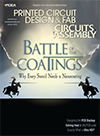News
COLLEGE PARK, MD – The 2nd Annual Symposium on Avoiding, Detecting, and Preventing Counterfeit Electronic Parts will be held Sept. 8 and 9 at University of Maryland, College Park, MD.
Submit abstracts on relevant topics (fewer than 300 words) to Dr. Diganta Das at diganta@umd.edu.
The deadline for presentations is August 16.
SMTA and CALCE will sponsor the event, which will focus on solutions available and under development by all sectors of the industry. Topics will include methodologies followed by affected industries to mitigate chances of being victims of counterfeit parts; efforts and initiatives – both domestic and international – that will affect the future of combating counterfeit electronic parts; supply chain management tools to mitigate counterfeit part risks; tools being developed and used by part manufacturers; inspections tools and techniques for detecting counterfeit parts; impact of counterfeit parts on the military and avionics industry; sources of counterfeit parts, and authentication techniques for securing electronic part supply chain.
For more information, visit http://www.calce.umd.edu and http://www.smta.org/education/education.cfm#counterfeit.
STOCKHOLM – SMT equipment manufacturer Mydata has acquired its German distributor Royonic.
SHENZHEN – Software provider Valor Computerized Systems Ltd. has established a technological partnership with Guilin University of Electronic Technology in China.
Under the terms of the agreement, Valor will provide GUET with software, including DFM, SMT programming, optimization, program conversion and process engineering, and GUET will bring Valor software into its educational programs, such as mandatory and elective courses in undergraduate and postgraduate studies.
In addition, a GUET-Valor Training Room for Electronic Manufacturing Software Application will be established for vocational training and open technological training courses.
No other financial terms of the agreement were disclosed.
LAS VEGAS – IPC has issued a call for abstracts for next year's Apex. The event will take place in Las Vegas, March 31 - April 2.
Expert presentations are being sought on all relevant design, PCP fabrication and manufacturing topics. Submissions in the areas of new materials and environmental concerns are especially encouraged. The program committee will choose only abstracts that describe significant results from experiments, emphasize new techniques or discuss trends and test results.
The deadline for abstracts is July 18.
For more information on submitting a conference abstract and/or course proposal, visit www.GoIPCShows.org/CFP.
For information on teaching a course, contact Michelle Michelotti, IPC coordinator of professional development, at MichelleMichelotti@ipc.org.
RENO – Market research firm DataBeans Inc. predicts the worldwide optoelectronics annual market will grow to $17.4 billion in 2008, up 8.6% year-over-year.
The firm expects a CAGR of 12% between 2008 and 2013, when the market will reach $31.2 billion.
Databeans predicts global optoelectronics revenue for lighting and other consumer applications will grow at a CAGR of 14% during the next five years, followed by the medical market, with a growth rate of 13%, and automotive, with growth of 12%.
STAMFORD, CT – Gartner Inc. has raised its 2008 worldwide IC forecast from 3.4% to 4.6%. The firm now says the IC industry is projected to reach $287 billion this year.
Press Releases
- Tagarno Sees Strong US Sales Growth in 2025, Driven by T50 and Software Demand
- Kimball Electronics Sets Date for Ribbon-Cutting at New Indianapolis Medical Manufacturing Facility
- Nordson’s SELECT Synchro Selective Soldering System Helps Kamstrup Advance Automation, Increase Output 20%, and Reclaim 6 Meters of Factory Floor Space
- Pinnacle Technology Group, Now PTG Electronics, Launches New Brand Identity, Strengthening Its Commitment to Innovation and Progress


